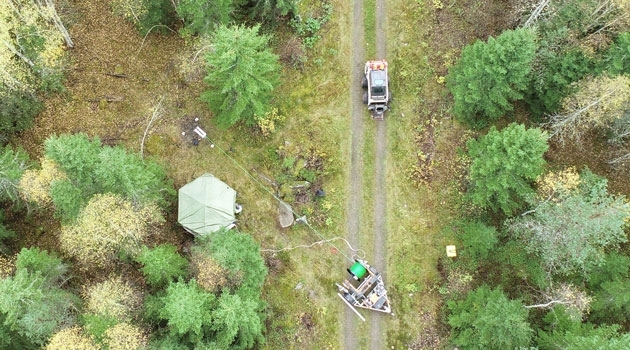Five smart solutions for the mining industry
Five prototypes to improve work in the mining industry. They are the result of the EU project Smart Exploration, which has been led by Uppsala University. “The mining industry has a great demand for cost-effective and environmentally friendly methods,” says Alireza Malehmir, research director of the project.
and the research coordinator of Smart Exploration.
Foto: Mikael Wallerstedt
The EU project, with 27 different partners in academia and industry and a budget of 5.2 million euros, has recently been completed. Alireza Malehmir, a professor at Uppsala University and the research coordinator, is very pleased with the results.
“We have been fast and productive and developed five prototypes of instruments, which are now on the European Commission’s innovation platform. We have also developed six methods in the form of software.”
Three of the prototypes were developed here in Sweden in projects led by researchers from Uppsala University or where the University has been a partner. One of these is a GPS time-system developed in cooperation with the MicNordic company. It transmits GPS information from inaccessible areas 1,500 to 2,000 metres underground.
Drones that measure electrical fields
The second is a system for electromagnetic measurements that makes it possible to measure electrical and electromagnetic fields using unmanned aerial vehicles (UAVs). It was developed along with the Geological Survey of Sweden and AMKVO, an Uppsala-based company.
“These products can easily enter the market, where there is a great demand for them. We have just signed a partnership agreement with a company in Australia. Some of these solutions, such as the UAV system, will be used in connection with the company’s ore deposits in northern Europe, where graphite is mined,” says Malehmir.
The third prototype originating in Sweden is a digital system for seismic-magnetic temperature measurements developed by the company Bitsim.
“Mining companies drill very narrow holes about five centimetres in diameter, making it very difficult to get instruments into them. So we developed a system that makes it possible to measure around these boreholes. It is completely digital and very user-friendly.”
Getting the results to industry
The other two prototypes were developed in collaboration with a Danish and a Dutch company. They use helicopters and electric vibrators for underground mapping. Over a hundred scholarly articles have already been published by more than 30 doctoral students and postdoctoral researchers involved in the project. Work is now continuing to get the results to the mining industry.
“There is a great demand for metals, both rare ones and more common metals such as iron. The problem is that many of the traditional exploration methods are based on subterranean drilling. In Sweden and Europe, that can be very expensive. The solutions we have developed enable instead to obtain high-resolution images of environmentally friendly, socially accepted targets that can later be drilled.”
What was it like to collaborate with companies?
“It worked great. We researchers have an ability to review the results and sometimes say ‘no, that’s not the case’, and the companies are very committed to solving the problem.”
Companies test new methods
To take the prototypes to market, companies need to collect successful examples. There are interested companies in Australia and Canada, but also in Sweden, where partnerships with Nordic Iron Ore and Ludvika municipality have created.
Nordic Iron Ore tested all three solutions developed in Sweden in its mine, and Ludvika municipality was involved in disseminating information on how new technology can improve exploration and mining operations.
What results can the new methods produce?
“For example, at Nordic Iron Ore’s mining site, we managed to provide 3D images of likely mineral deposits by extending the mine another 300 metres sideways and deeper. If our estimate is correct, there are about 10 million tonnes of iron oxide deposits worth drilling for. So this can serve as a very good indicator for companies,” says Malehmir.
Annica Hulth
Smart exploration
Smart Exploration consists of a research and application team, and supports by a group of technologically advanced SMEs and mining companies. The focus is on developing cost-effective, environmentally-friendly tools and methods for geophysical exploration, as well as other aspects such as geological and geochemical target vectoring and generations. The project includes 27 partners from 11 countries and six exploration sites within Europe.

